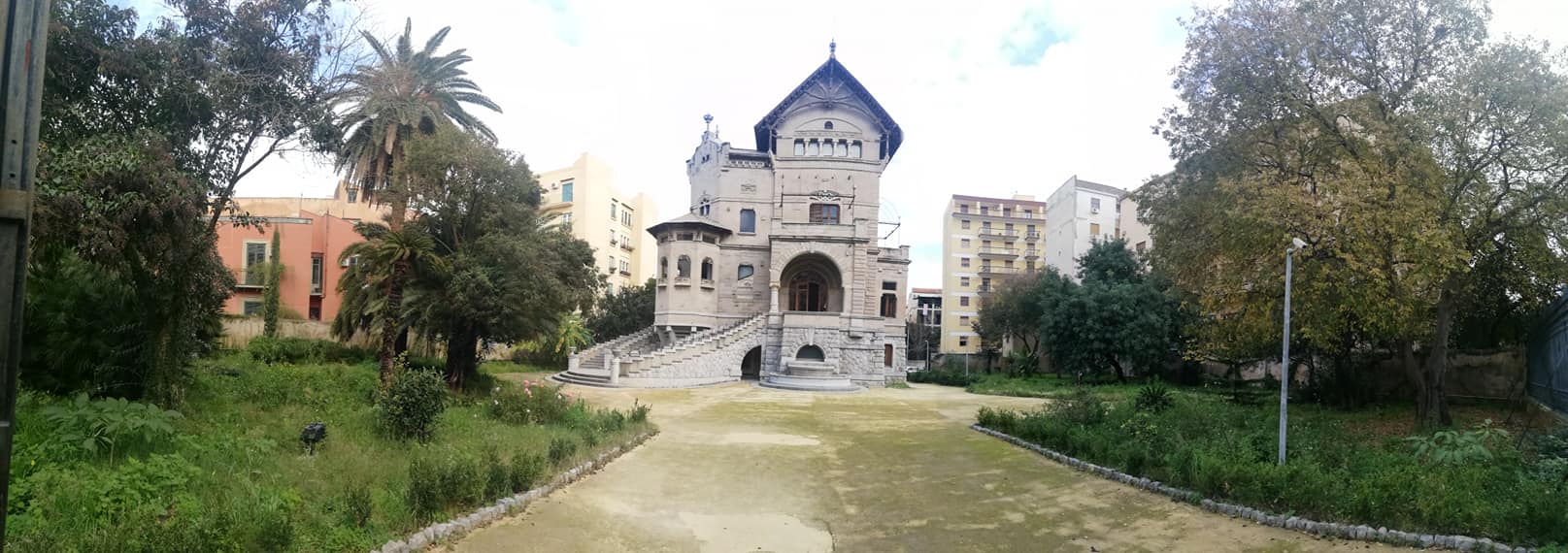Read
English version
Ideato e progettato tra il 1900 ed il 1901 da Ernesto Basile, su incarico della Famiglia Florio, il Villino Florio all’Olivuzza era considerato un “padiglione di delizia” immerso in un parco con angoli che sapevano di romantico e fiabesco. Il tipo di costruzione, modernista, costituiva un “divertissement“, che, con il serraglio, il laghetto, la serra per le orchidee, il chioschetto siculo-normanno e il tempietto neoclassico, doveva rappresentare al meravigliato visitatore la grandezza della famiglia che lo aveva commissionato.
Il villino è a tre piani ed era arredato con mobili progettati da Ernesto Basile, il quale coordinò l’intervento di tutte le altre maestranze che vi intervennero: i pittori Ettore De Maria Bergler e Giuseppe Enea per le pitture murali e gli affreschi, Salvatore Gregorietti per le vetrate dipinte, le Ditte Muccoli e Golia, Ducrot, Florio e Caraffa per il legno e la ceramica,e infine la Società Trinacria per gli impianti elettrici.
Nell’anno 1962, tra il 23 e il 24 novembre, un incendio doloso distrusse gli interni e parte degli esterni.
Nello stesso anno si cominciò a pensare di salvare il Villino Florio ma solo nel 1995 si è arrivati alla decisione che il suddetto villino fosse ” utilizzato quale museo della Belle Epoque nonché museo di se stesso, quale esempio della tipologia abitativa dell’imprenditoria palermitana dell’epoca”.
Da allora un lento ma proficuo restauro ha preservato il monumento dall’incuria, si è cercato di riprodurre filologicamente le parti decorative che si potevano documentare e si è cercato di ricreare un’opera nella quale fosse ancora leggibile la regola e l’immaginazione che avevano mosso coloro che facevano nuova architettura nel periodo Liberty.
Foto: Mario Dragotto
Indirizzo: Viale Regina Margherita, 38
Contatti: tel. 091 702 54 71
*English
Designed between 1900 and 1901 by Ernesto Basile, commissioned by the Florio family, Villino Florio all’Olivuzza was considered a delight pavilion immersed in a park with romantic and fairytale-like spots. The type of construction, that is Modernist, constituted a divertissement, which, along with the animal menagerie, the pond, the greenhouse for orchids, the Sicilian-Norman kiosk and the neoclassical temple, was to represent to the astonished visitor the greatness of the family that had commissioned it.
The villa has three floors and was enriched with furniture designed by Ernesto Basile, who coordinated the intervention of all the other artists who took part in it: the painters Ettore De Maria Bergler and Giuseppe Enea for the murals and frescoes, Salvatore Gregorietti for the stained glass windows, the Muccoli and Golia, Ducrot, Florio and Caraffa companies for wood and ceramics, and finally the Trinacria Society for electrical installations.
In 1962, between the 23th and 24th of November, both the Villino interior and part of the exterior were destroyed by arson.
In the same year someone began to think about saving Villino Florio but only in 1995 it was agreed that the aforementioned cottage had to be “used as a museum of the Belle Epoque as well as a museum of itself, as an example of the housing typology of Palermo’s entrepreneurship era. “
Since then, a slow but fruitful restoration has preserved the monument from neglect, an interesting attempt has been made to reproduce the decorative parts that could be documented and another attempt to recreate philologically a work of art in which it was still perceivable the applied architectural rule along with imagination which had inspired those who designed a new architecture in the Art Nouveau style.
Address: Viale Regina Margherita, 38
Ticket: free






